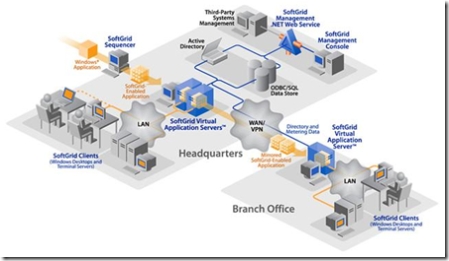So I have the 4.1 Software, What's the difference!
I am going to do two things in this blog! Talk a little bit about the versions of SoftGrid you can get (i.e. Terminal Services and Windows Desktop) and then drill into what you get in the CD.
So I wanted to start with an architecture diagram.
In this diagram we can see the basic high level architecture that SoftGrid requires to function correctly. The end points for all of our SoftGrid Infrastructure is our Clients.
So to the first question, The difference between the Terminal Server and the Windows Desktop Client.
We have a SoftGrid Terminal Server Client, this is designed and for use on Windows 2000, and 2003 Terminal Servers. It allows the platforms to run vitalized applications for multiple users using the same cache on the server.
The other client end point is a SoftGrid Windows Desktop Client. This can be used on Windows 2000 and Windows XP clients.......... and soon with Version 4.2 of the Client Windows Vista! This client allows vitalized applications created on the SoftGrid Sequence to be streamed and run on the local clients.
What is the difference between the Terminal Services SoftGrid CD and The MDOP Windows Desktop SoftGrid CD?............. The Clients!!!! Now why is this an important thing to take note off? Well everything else is the same and is a shared resource in the infrastructure!
So just to clear up the original point....What comes on the CD
- SoftGrid Virtual Application Server (This is a shared resource and can be used for both the Terminal Server and Windows Desktop Client, so this installation is an install once use for all clients and is the same media regardless of which CD install you have)
- SoftGrid Sequencer (Again the Sequencer can be used and installed on any platform that is supported regardless of which version of the product you buy. Again this is the same client on either CD)
- The Client! (Now depending on what you have purchased and your licence agreement with Microsoft off course! Will mean you will either have the Terminal Server Client or Windows Desktop Client)
